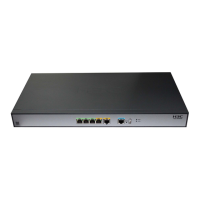61
network-operator
Parameters
class: Specifies the local user type.
manage: Device management user.
network: Network access user.
guest: Guest user account.
idle-cut { disable | enable }: Specifies local users with the idle cut feature disabled or enabled.
service-type: Specifies the local users that use a specific type of service.
• advpn: ADVPN tunnel users.
• ftp: FTP users.
• http: HTTP users.
• https: HTTPS users.
• ike: IKE users that access the network through IKE extended authentication.
• ipoe: IPoE users that access the network through Layer 2 or Layer 3 leased lines or STBs.
• lan-access: LAN users that typically access the network through an Ethernet, such as 802.1X
users.
• pad: X.25 PAD users.
• portal: Portal users.
• ppp: PPP users.
• ssh: SSH users.
• sslvpn: SSL VPN users.
• telnet: Telnet users.
• terminal: Terminal users that log in through console ports, AUX ports, or async ports.
state { active | block }: Specifies local users in active or blocked state. A local user in active state
can access network services, but a local user in blocked state cannot.
user-name user-name: Specifies all local users using the specified username. The username must
be a case-sensitive string of 1 to 55 characters that does not contain the domain name.
vlan vlan-id: Specifies all local users in a VLAN. The vlan-id argument is in the range of 1 to 4094.
Usage guidelines
If you do not specify any parameters, this command displays information about all local users.
Examples
# Display information about all local users.
<Sysname> display local-user
Device management user root:
State: Active
Service type: SSH/Telnet/Terminal
Access limit: Enabled Max access number: 3
Current access number: 1
User group: system
Bind attributes:
Authorization attributes:
Work directory: flash:
User role list: network-admin

